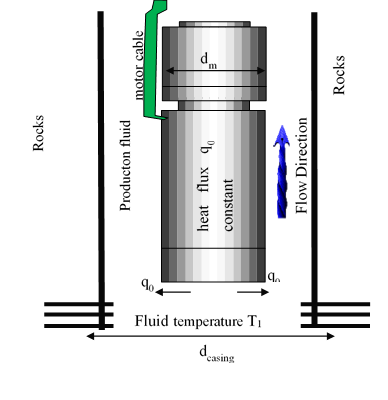Empirical Model for Heat Transfer of Electric Submersible Pump (ESP) Motor at Oil Producer Well
Abstract
Motor operating temperature at wells equipped with Electric Submersible Pump (ESP) need to be monitored to maintain ESP performance run life. Not all producer wells equipped with temperature sensor, so it considered necessary to build mathematic model to estimate motor operating temperature. Model of heat transfer to predict motor operating temperature is developed based on empirical equation method. Parameter and variable data obtained from producer wells include water cut, viscosity, specific gravity, operating temperature, ampere and voltage. Procedure to calculate viscosity is ASTM D-88 and procedure to calculate specific gravity is ASTM D-5002.
From 18 wells data obtained from the field, calculated reynolds numbers indicate turbulent flow regime with reynold numbers more than 4,000. Nusselt number were calculated using multiple linear regression with result of Nu = 0.06 * Re0.65 * Pr0.36 with error of 1.3% from downhole sensor measurement. The comparison with similar research also provided that use different Nusselt number empirical equation.
The conclusion from the research showing that empirical approach by using specific constants to predict Nusselt number can be used to predict more accurate heat transfer coefficient with error 1.3%. Higher water cut fluid flow need lower fluid velocity to achieve motor operating temperature below motor limit temperature with fluid velocity above 0.3 m/s.
Full text article
References
American Petroleum Institute. (2013). Recommended Practice for Sizing and Selection of Electrical Submersible Pump Installations. API Recommended Practice 11S4 Third Edition. USA.
Bianco, V., Nardini, S., & Manca, O. (2011). Enhancement of heat transfer and entropy generation analysis of nanofluids turbulent convection flow in square section tubes. Nanoscale Research Letters, 6(1), 1–12. https://doi.org/10.1186/1556-276X-6-252
Bird, R. B., Stewart, W. E., & Lightfood, E. N., (2002). Transport Phenomena Second Edition. John Wiley & Sons Inc. United States of America.
Bough, M., Orrego, Y. A., Waldner, L. Ben, Sheth, K. K., O’Bryan, R., Jankowski, T. A., & Pregner, C. (2014, October 6). Enhanced Cooler-Operating ESP Motor Design and Field Trials. SPE Artificial Lift Conference & Exhibition-North America. https://doi.org/10.2118/171347-MS
Du, M., Jin, N. De, Gao, Z. K., Wang, Z. Y., & Zhai, L. S. (2012). Flow pattern and water holdup measurements of vertical upward oil-water two-phase flow in small diameter pipes. International Journal of Multiphase Flow, 41, 91–105. https://doi.org/10.1016/j.ijmultiphaseflow.2012.01.007
Elam, S. K., Tokura, I., Saito, K., & Altenkirch, R. A. (1989). Thermal conductivity of crude oils. Experimental Thermal and Fluid Science, 2(1), 1–6. https://doi.org/10.1016/0894-1777(89)90043-5
Galvão, H. L. C., Oliva, G. B. F. F., Dos Santos, D. P., Maitelli, A. L., Costa, R. O., & Maitelli, C. W. S. P. (2015). Computational Model of Heat Transfer in ESP System for Deviated Wells. SPE Artificial Lift Conference - Latin America and Caribbean, 490–499. https://doi.org/10.2118/173971-ms
Guo, B., Lyons, W.C., & Ghalambor A., (2007). Petroleum Production Engineering. Elsevier Science and Technology Books. Lousiana USA.
Incropera, F. P., Dewitt, D. P., Bergman, T. L., & Lavine, A. S. , (2008). Fundamentals of Heat and Mass Transfer. John Wiley and Sons. USA.
Manca, O., Nardini, S., & Ricci, D. (2011). Numerical Analysis of Water Forced Convection in Channels with Differently Shaped Transverse Ribs. Journal of Applied Mathematics, 2011(Specia Issue). https://doi.org/10.1155/2011/323485
Manning, F. S., & Thompson, R. E., (1995). Oilfield Processing Volume Two: Crude Oil, Tulsa : PennWell Publishing Company.
Oon, C. S., Togun, H., Abdulrazzaq, T., Kazi, S. N., Badarudin, A., Kadhum, A. A. H., & Sadeghinezhad, E. (2014). A Review of Studies on Forced, Natural and Mixed Heat Transfer to Fluid and Nanofluid Flow in an Annular Passage. Renewable and Sustainable Energy Reviews, 39(November 2014), 835–856. https://doi.org/10.1016/j.rser.2014.07.008
Ramires, M. L. V., & Nieto de Castro C. A., (1994). Standard Reference Data for the Thermal Conductivity of Water. American Institute of Physics and American Chemical Society. USA.
Sharma, K. V., Sarma, P. K., Azmi, W. H., Mamat, R., & Kadirgama, K. (2012). Correlations to Predict friction and Forced Convection Heat Transfer Coefficients of Water Based Nanofluids for Turbulent Flow in a Tube. International Journal of Microscale and Nanoscale Thermal and Fluid Transport Phenomena, 3(4), 1–25.
Sinnott, R.K., (2005). Coulson and Richardson’s Chemical Engineering Series : Chemical Engineering Design. Volume 6. Fourth Edition. Elsevier England.
Skočilasová, B., Skočilas, J., & Soukup, J. (2018). Forced convection and heat transfer around a bounded cylinder. MATEC Web of Conferences, 157, 02045. https://doi.org/10.1051/MATECCONF/201815702045
Authors
This is an open access journal which means that all content is freely available without charge to the user or his/her institution. The copyright in the text of individual articles (including research articles, opinion articles, and abstracts) is the property of their respective authors, subject to a Creative Commons CC-BY-SA licence granted to all others. JEEE allows the author(s) to hold the copyright without restrictions and allows the author to retain publishing rights without restrictions.




